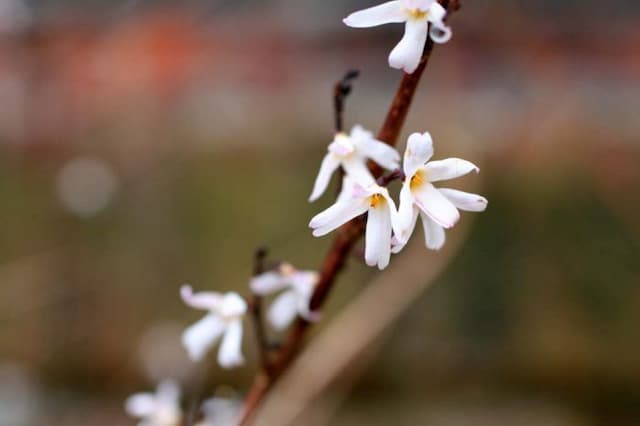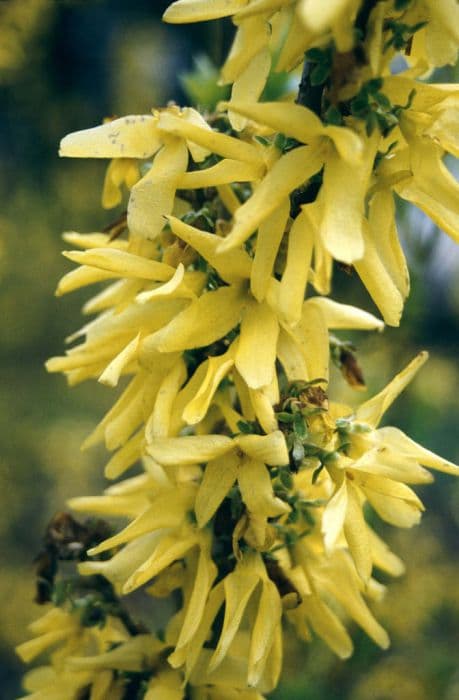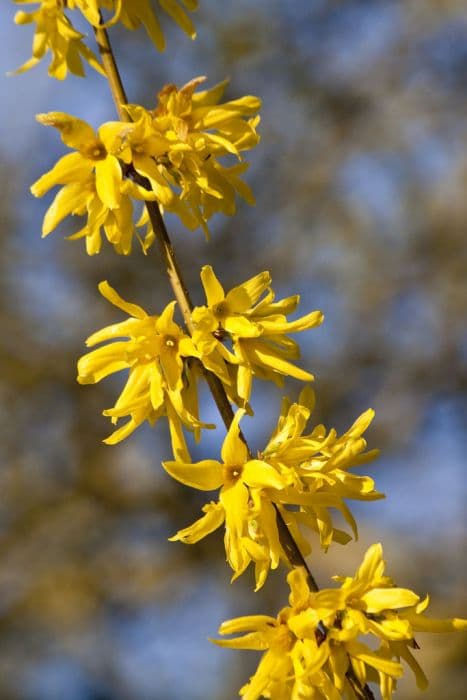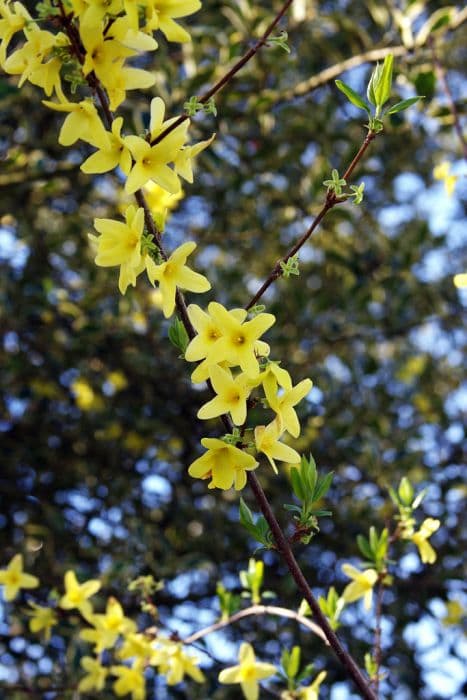Golden Privet Ligustrum ovalifolium 'Vicaryi'
ABOUT
The plant referred to as Golden Privet features oval-shaped leaves that usually show off a vibrant, golden-yellow color, especially when they are young or in full sunlight. As the leaves mature, they may become a more greenish-yellow hue. The overall foliage offers a dense and bushy presentation, creating a lush appearance. In the spring or early summer, Golden Privet produces clusters of small, creamy-white flowers. These blossoms may not be as showy as other flowering plants but they do lend a subtle charm and can attract pollinators like bees. Following the flowering season, the Golden Privet may bear small, dark, berry-like fruit. However, the fruit is not particularly noticeable against the bright foliage and is generally considered inconsequential to the plant's ornamental value. Overall, the foliage is the standout feature of Golden Privet, providing a striking contrast in gardens and landscapes. The plant is often used as a hedge or a decorative shrub due to its colorful leaves and dense growth habit, providing year-round interest.
About this plant
 Names
NamesFamily
Oleaceae.
Synonyms
Golden Privet, Vicary Golden Privet, Yellow-leaved Privet.
Common names
Ligustrum ovalifolium 'Vicaryi'.
 Toxicity
ToxicityTo humans
The Golden Privet, while an ornamental shrub popular in landscaping, does possess toxic properties that can affect humans if ingested. All parts of the plant, particularly the berries, contain compounds that can potentially cause symptoms if consumed. These symptoms might include abdominal pain, nausea, vomiting, and diarrhea. In some cases, the ingestion could also lead to more severe reactions, such as respiratory issues or an accelerated heart rate. If you suspect someone has ingested Golden Privet, it is important to seek medical attention immediately.
To pets
The Golden Privet is toxic to pets, including cats and dogs. All parts of the plant, including leaves and berries, contain glycoside compounds which can cause poisoning if ingested by your pet. The symptoms of poisoning in pets may include gastrointestinal upset, such as vomiting and diarrhea, as well as more serious health issues like depression, loss of coordination, and in extreme cases, respiratory failure or coma. If you believe your pet has ingested Golden Privet, it is crucial to contact your veterinarian or an emergency animal care center immediately.
 Characteristics
CharacteristicsLife cycle
Perennials
Foliage type
Semi-deciduous
Color of leaves
Variegated
Flower color
White
Height
10-15 feet (3.0-4.6 meters)
Spread
10 feet (3 meters)
Plant type
Shrub
Hardiness zones
5
Native area
Japan
Benefits
 General Benefits
General Benefits- Landscape Aesthetics: Golden Privet offers bright golden-yellow foliage that adds striking color and contrast to garden landscapes.
- Privacy Screening: Its dense growth habit makes it an effective natural screen or hedge, providing privacy and reducing noise pollution.
- Low Maintenance: Golden Privet is known to be relatively low maintenance, requiring little care once established, making it suitable for various gardeners.
- Tolerance to Conditions: The plant is tolerant of a variety of soil types and urban conditions, which makes it a versatile choice for many locations.
- Wildlife Habitat: It can provide shelter and nesting sites for birds, thereby supporting local biodiversity.
- Easily Shaped: Due to its growth pattern, Golden Privet can be easily pruned and shaped, making it ideal for formal gardens and topiary designs.
- Seasonal Interest: Golden Privet holds its foliage throughout the year, offering winter interest in landscapes that can become bare in colder months.
- Drought Resistance: Once established, it can withstand periods of drought, which is beneficial in areas with water restrictions.
 Medical Properties
Medical PropertiesThis plant is not used for medical purposes
 Air-purifying Qualities
Air-purifying QualitiesThis plant is not specifically known for air purifying qualities.
 Other Uses
Other Uses- Privacy Screening: The dense foliage of Vicary golden privet makes it suitable for creating living screens or hedges that offer privacy and reduce noise from streets and neighbors.
- Topiary: This plant can be pruned into various shapes and forms for decorative purposes in gardens, making it ideal for topiary art.
- Windbreaks: Vicary golden privet can be used to protect more sensitive plants from strong winds when planted as a shelterbelt or windbreak hedge.
- Erosion Control: The root system of this shrub can help stabilize soil on slopes and banks, preventing erosion.
- Urban Landscaping: It is rugged enough to be used in urban areas to green up spaces like roundabouts, median strips, and parking lot borders due to its tolerance to pollution.
- Wildlife Shelter: The dense branches provide shelter for birds and small mammals, offering a safe haven from predators and harsh weather.
- Garden Structure: Its quick-growing and dense characteristics provide a year-round structure in gardens, maintaining visual interest even in winter.
- Craft Material: The wood of Vicary golden privet can be used in crafting small objects such as woven baskets or simple walking sticks.
- Photography Backdrop: The consistent and lush foliage can serve as a backdrop for outdoor portrait photography.
- Seasonal Interest: With its golden-yellow leaves, Vicary golden privet adds a burst of color in spring and summer, contrasting nicely with other green plants.
Interesting Facts
 Feng Shui
Feng ShuiThe Golden Privet is not used in Feng Shui practice.
 Zodiac Sign Compitability
Zodiac Sign CompitabilityThe Golden Privet is not used in astrology practice.
 Plant Symbolism
Plant Symbolism- Protection - Ligustrum ovalifolium 'Vicaryi', commonly known as Golden Privet, is often used in hedges and borders, symbolizing a protective barrier or shield around a home or garden.
- Boundaries - Since Golden Privet is typically planted in rows to demarcate space, it is symbolic of setting clear limits and boundaries in one’s life.
- Privacy - Given its use as a privacy screen, the Golden Privet represents the human desire for a personal sanctuary and private space.
- Purity - With its dense foliage and ability to absorb pollutants, it can symbolize the cleansing and purifying of an environment or personal milieu.
- Resilience - As a hardy shrub that can withstand various conditions, Golden Privet symbolizes strength and the ability to thrive through adversity.
 Water
WaterGolden privet requires regular watering to maintain soil moisture, especially during dry spells. Typically, water the plant with 1 to 2 inches of water each week, which translates to about 0.6 to 1.2 gallons for a small to medium-sized plant. During hot and dry periods, increase the frequency to twice a week. Ensure deep watering to encourage root growth, but let the soil dry out slightly between waterings to avoid waterlogging. Reduce watering in the winter when the plant is not actively growing.
 Light
LightGolden privet thrives best in full sun to partial shade conditions. The ideal spot for planting would receive at least four to six hours of direct sunlight per day. However, the plant is versatile and can also tolerate more shaded areas, although it may affect the density of the foliage.
 Temperature
TemperatureGolden privet grows well in a wide range of temperatures but prefers a range between 40°F and 90°F. It is hardy and can withstand temperatures as low as -10°F, but growth will be best in temperate climates that don't experience extreme heat or cold. Ensure to protect the roots with mulch in winter if temperatures consistently fall below the hardiness range.
 Pruning
PruningPrune golden privet to shape it and to remove any dead or diseased branches, which promotes healthy growth and improves air circulation. The best time to prune is in late winter or early spring, before the onset of new growth. For formal hedges, pruning may be needed 2 to 3 times during the growing season to maintain the shape.
 Cleaning
CleaningAs needed
 Soil
SoilFor the Golden Privet, a well-draining soil mixture is ideal. Incorporate loam, peat moss, and sharp sand to create a fertile blend. The ideal soil pH for this shrub is between 6.5 and 7.5, ensuring it is slightly acidic to neutral.
 Repotting
RepottingGolden Privet is typically grown outdoors and does not require frequent repotting. If grown in a container, repot every 2-3 years to refresh the soil and provide room for growth.
 Humidity & Misting
Humidity & MistingGolden Privet is tolerant of a range of humidity levels and thrives in outdoor conditions. Average ambient humidity is generally suitable.
 Suitable locations
Suitable locationsIndoor
Place Golden Privet in bright, indirect light and pot in well-draining soil.
Outdoor
Plant in well-drained soil, full sun to partial shade, water regularly.
Hardiness zone
5-8 USDA
 Life cycle
Life cycleLigustrum ovalifolium 'Vicaryi', commonly known as Golden Privet, begins its life cycle as a seed, which upon germination will develop into a seedling. In optimal conditions, the seedling establishes itself and grows into a juvenile plant, gradually developing the characteristic golden-edged leaves. As it matures into an adult plant, it undergoes vegetative growth, forming a dense, leafy shrub that can be used in hedges and landscaping. During the spring and summer, the Golden Privet enters its reproductive stage, producing small, fragrant white flowers that are attractive to pollinators. After pollination, these flowers develop into small, berry-like fruits (drupes) that mature to a dark color and are dispersed by birds and other wildlife. The plant then enters a period of dormancy during the colder months, conserving energy before the next cycle of growth and reproduction in the following spring.
 Propogation
PropogationPropogation time
Spring-Early Summer
For the Golden Privet, Ligustrum ovalifolium 'Vicaryi', the most popular method of propagation is through semi-hardwood cuttings. This typically takes place in late summer. Take a cutting of about 4 to 6 inches (10 to 15 centimeters) long from a healthy portion of the plant. The cutting should have at least a couple of leaf nodes. Remove the leaves from the bottom half of the cutting and dip the cut end into rooting hormone to encourage root development. The cutting should then be planted in a pot filled with a mix of peat and perlite or sand, ensuring to keep the soil moist but not waterlogged. It's important to provide a warm environment and maintain high humidity around the cutting, often achieved by covering the pot with a plastic bag or a propagator. With proper care, the cutting should root in a few weeks, after which it can gradually be acclimatized to less humid conditions before transplanting.








